Abstract
OBJECTIVE: To test the influence of a chronic ultra mild stress (CUMS) procedure, based solely on socio-environmental stressors, on cognitive-behavioural function in mice. DESIGN: Behavioural study. PARTICIPANTS: B6D2F1 mice. INTERVENTIONS: Mice were exposed to various stressors and then tested using a decision-making task. RESULTS: We observed that stress facilitated "choice" behaviour, with an absence of "no choice" behaviour. Stress also facilitated a more rapid capacity to process information, a decrease in the level of evaluation of the choice situation and less hesitation. These stress-related consequences on decision making may be attributed to a higher level of distractability in the stressed mice. CONCLUSIONS: The CUMS model may be useful for the study of stress-related disorders by proposing a new method for assessing gene-environment interactions in cognitive-affective behaviours.
Full text
PDF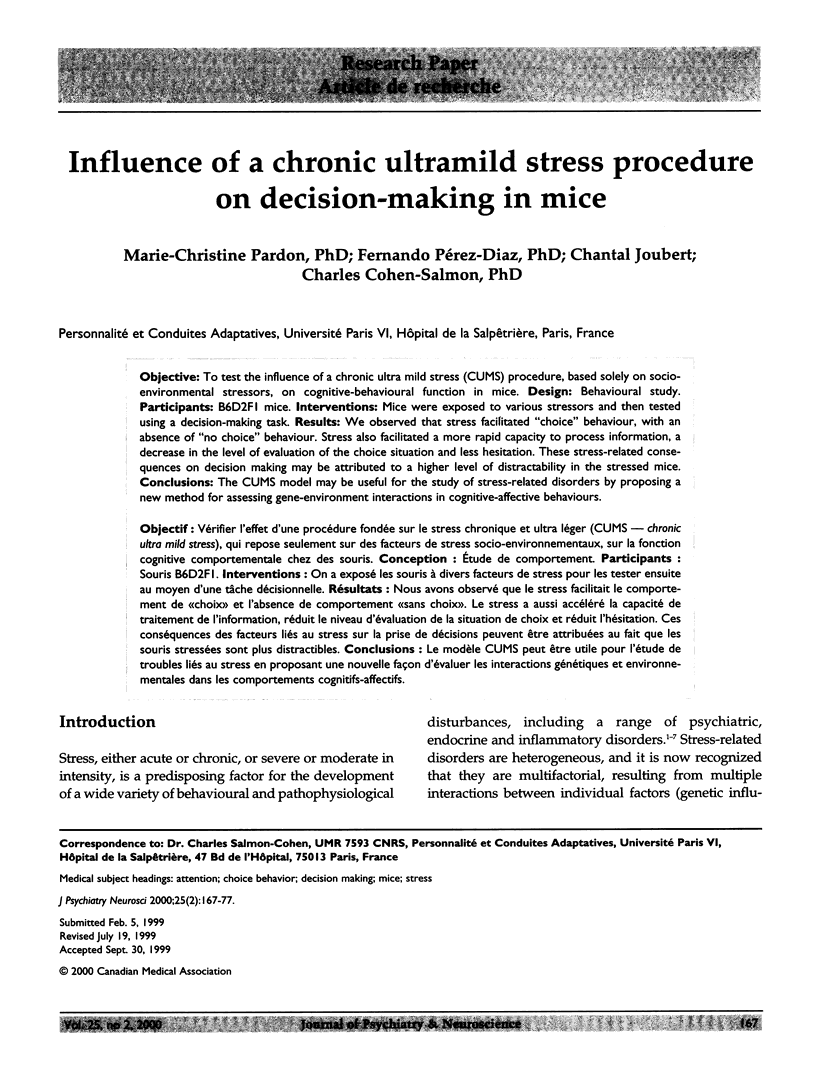
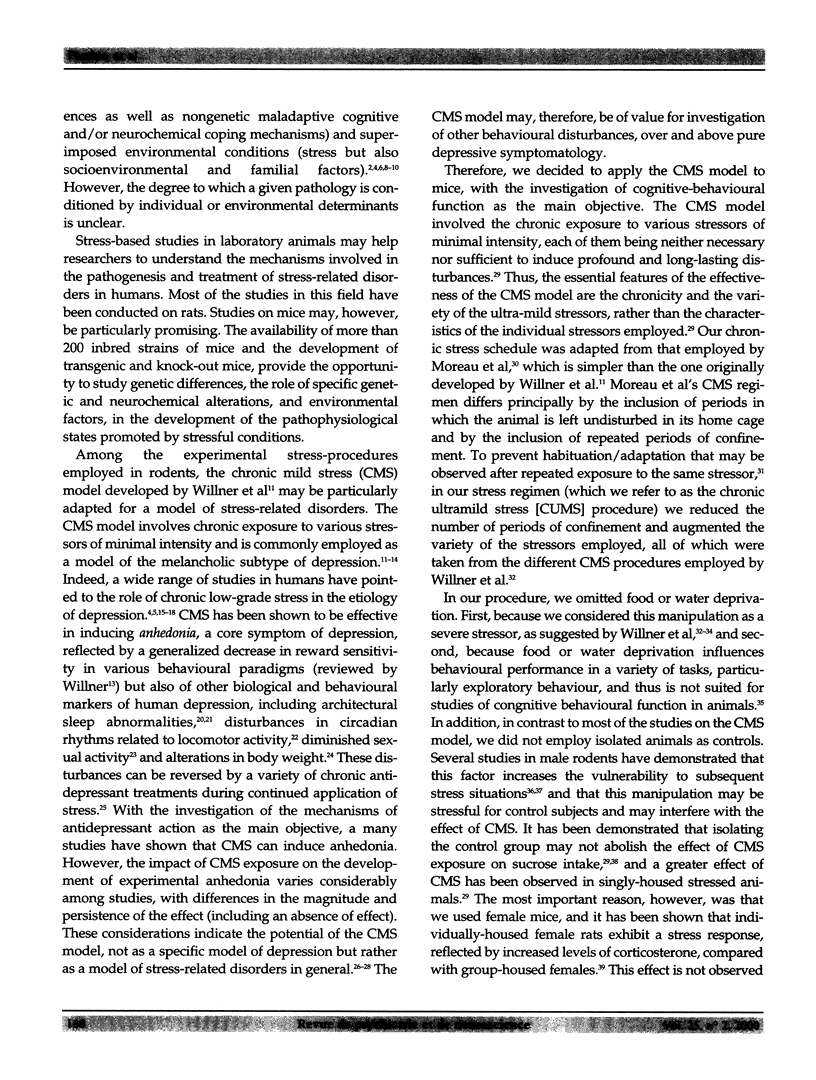
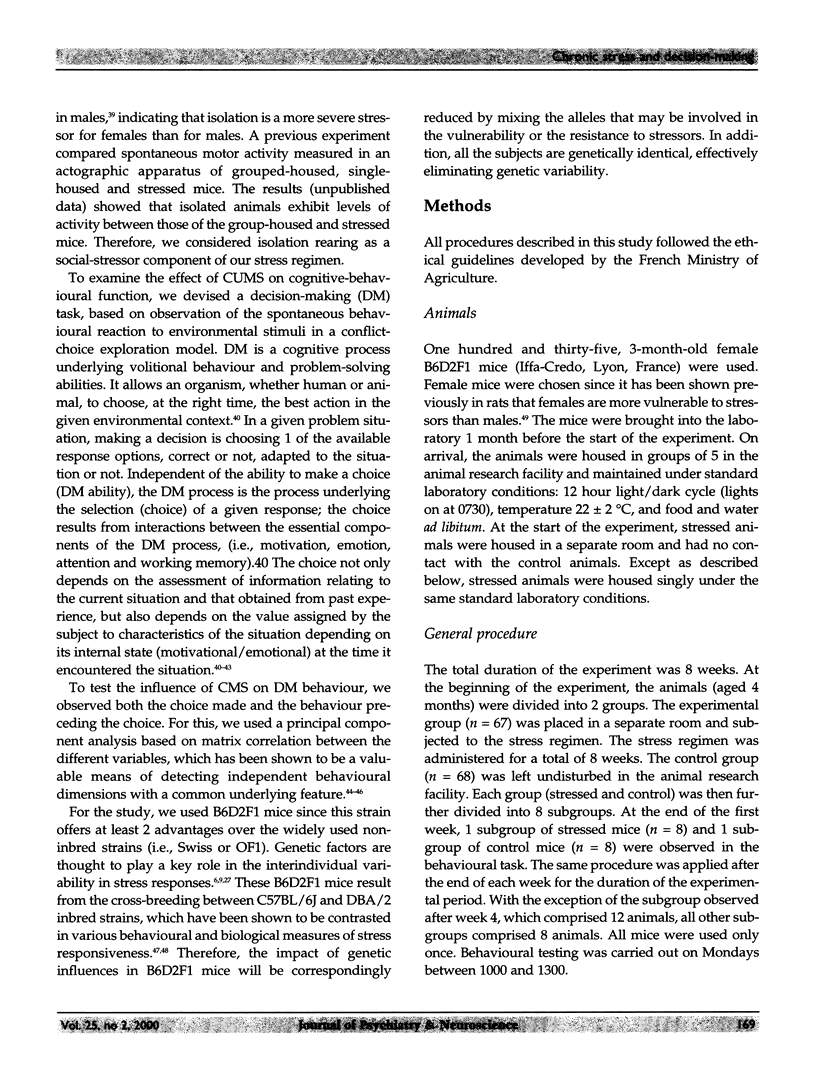
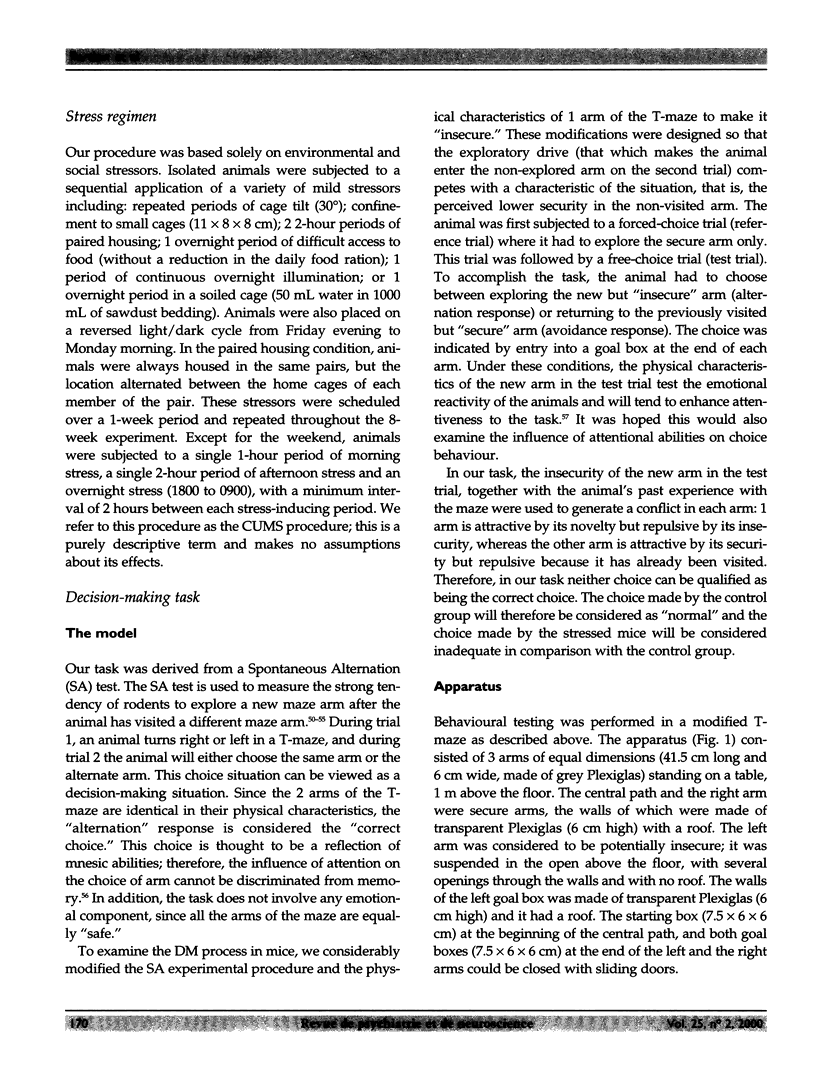
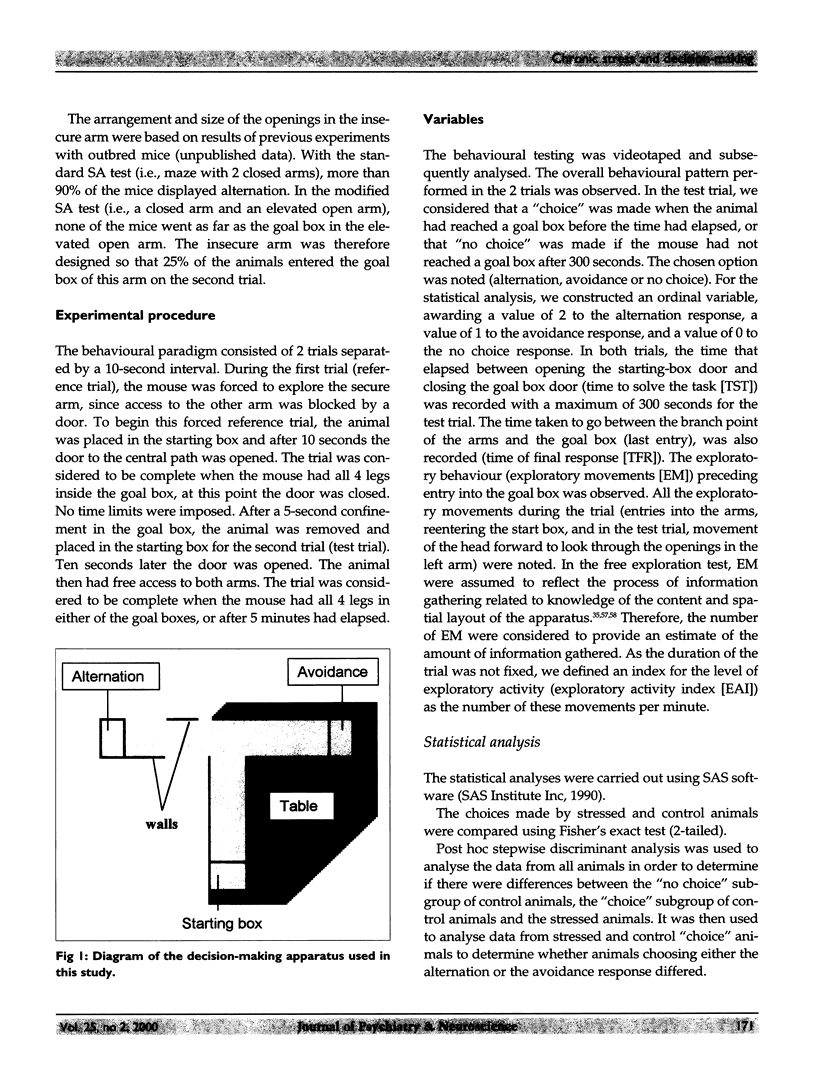
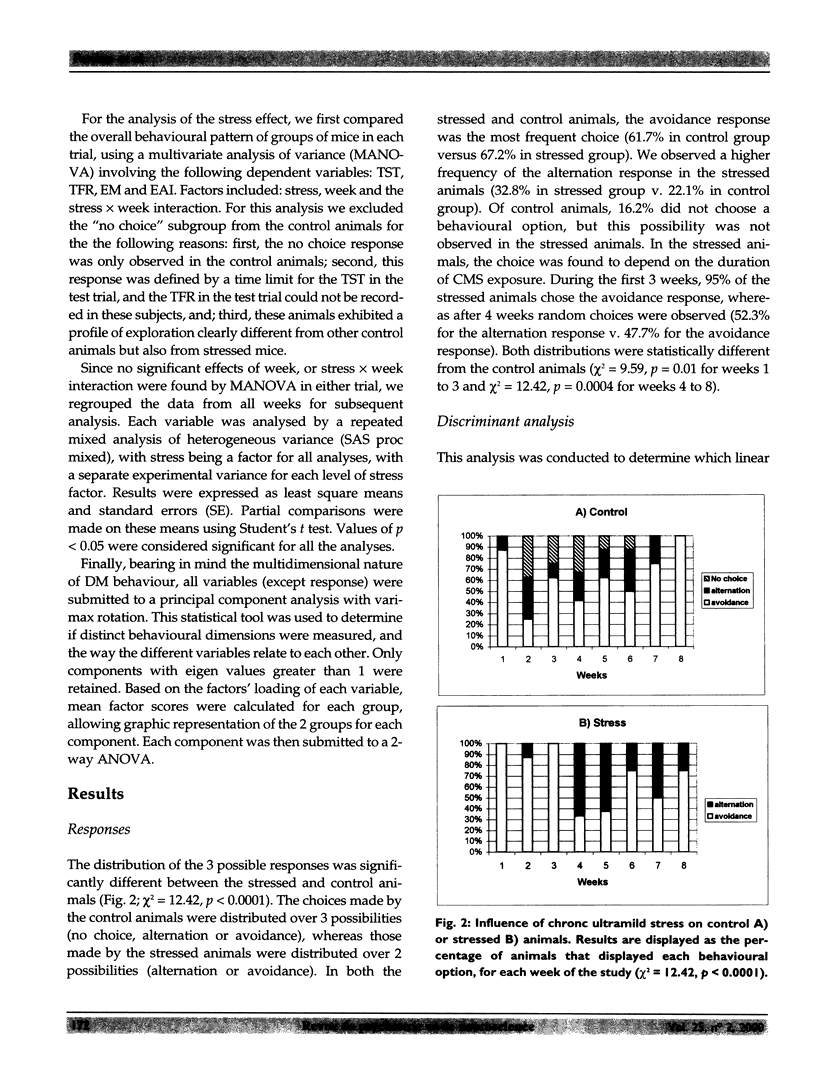
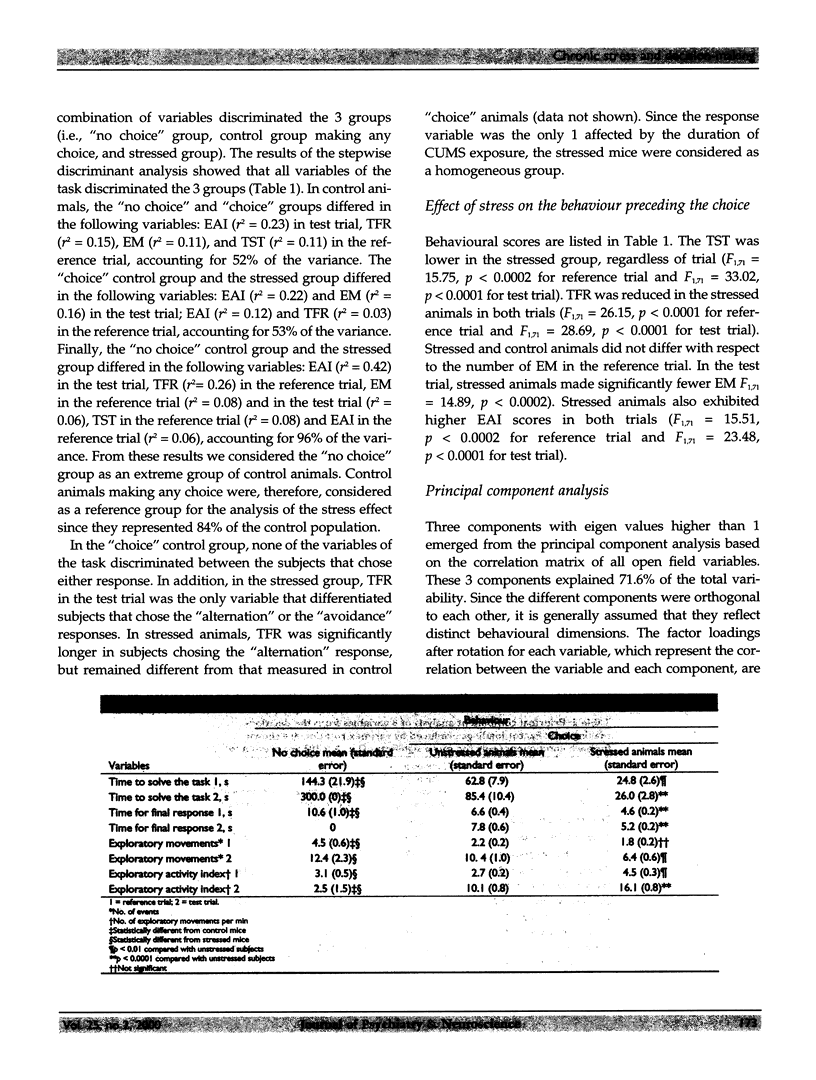
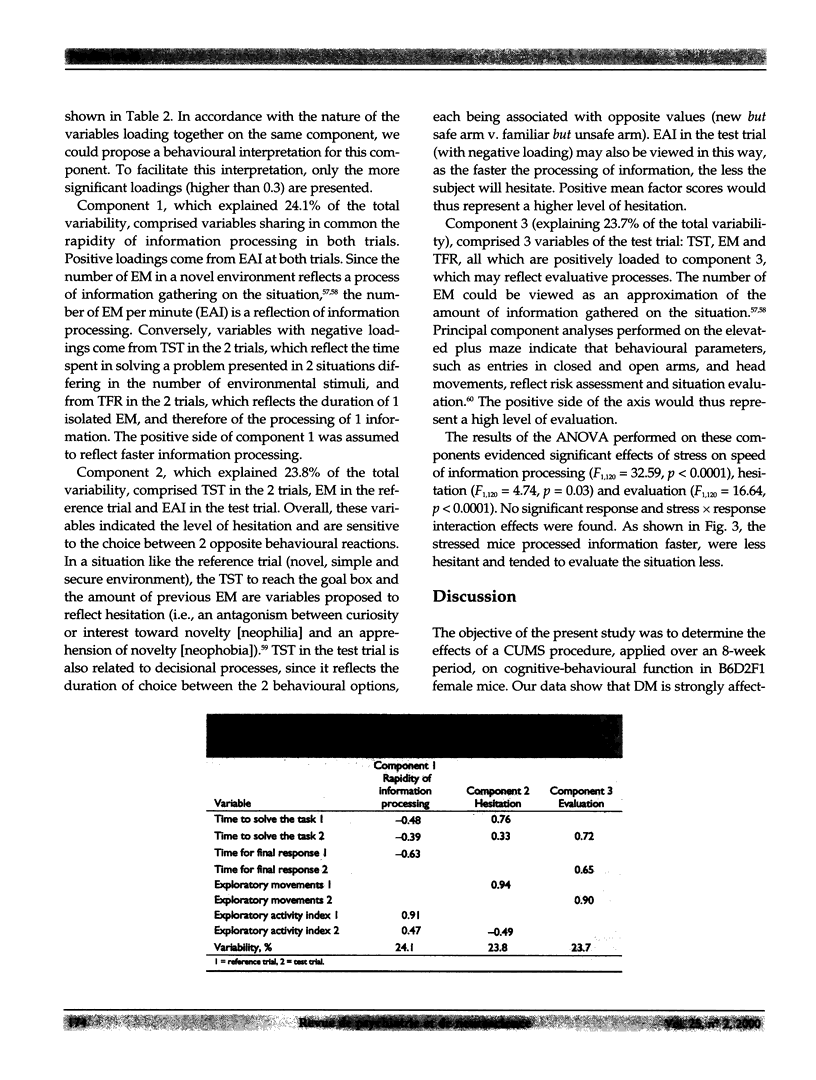
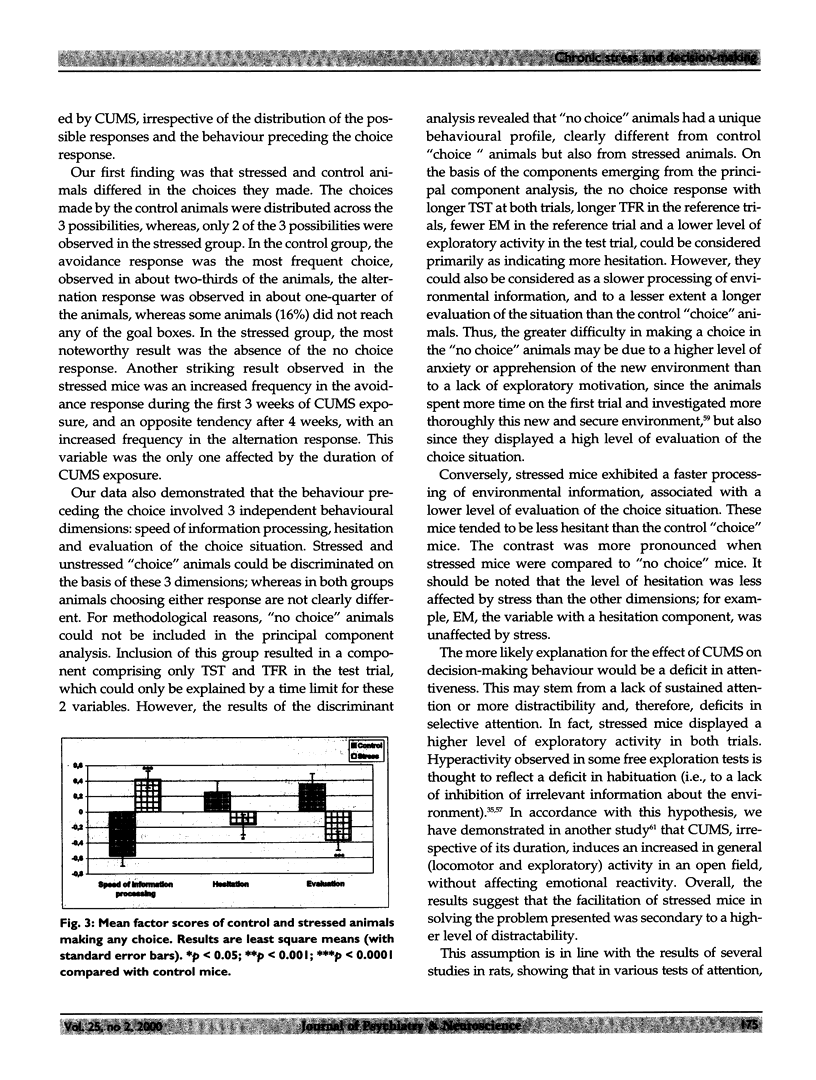
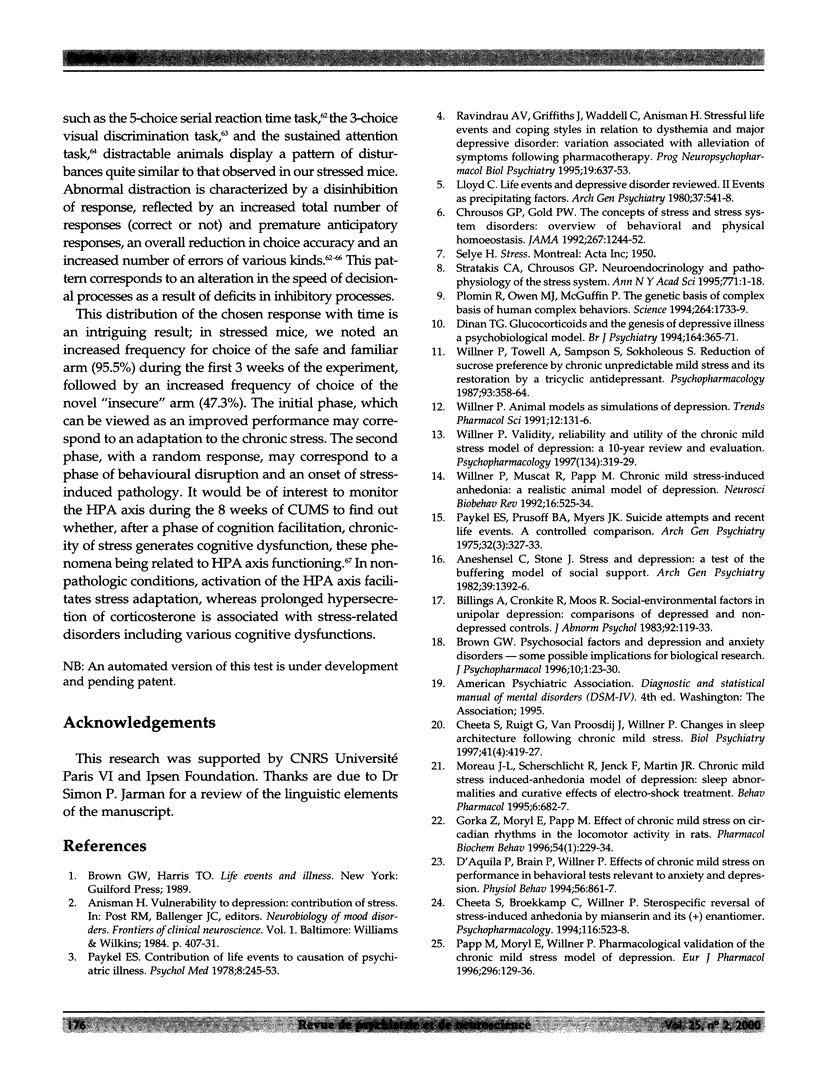
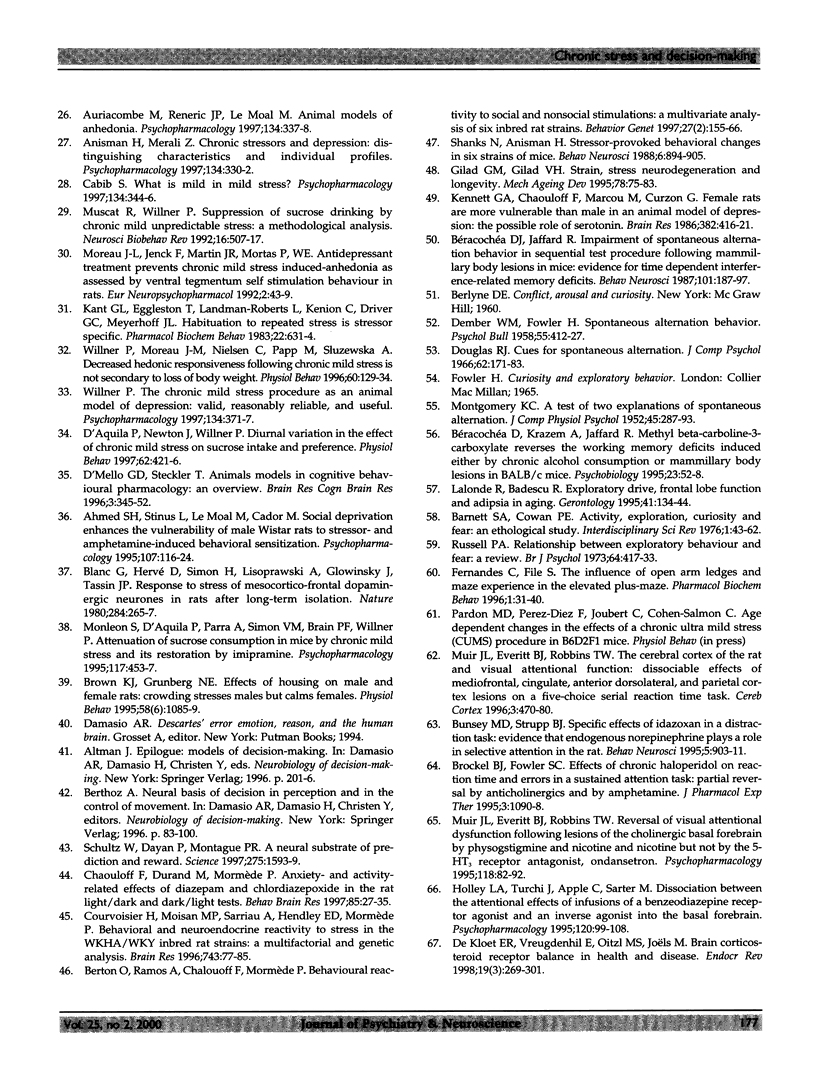
Selected References
These references are in PubMed. This may not be the complete list of references from this article.
- Ahmed S. H., Stinus L., Le Moal M., Cador M. Social deprivation enhances the vulnerability of male Wistar rats to stressor- and amphetamine-induced behavioral sensitization. Psychopharmacology (Berl) 1995 Jan;117(1):116–124. doi: 10.1007/BF02245106. [DOI] [PubMed] [Google Scholar]
- Aneshensel C. S., Stone J. D. Stress and depression: a test of the buffering model of social support. Arch Gen Psychiatry. 1982 Dec;39(12):1392–1396. doi: 10.1001/archpsyc.1982.04290120028005. [DOI] [PubMed] [Google Scholar]
- Anisman H., Merali Z. Chronic stressors and depression: distinguishing characteristics and individual profiles. Psychopharmacology (Berl) 1997 Dec;134(4):330–377. doi: 10.1007/s002130050457. [DOI] [PubMed] [Google Scholar]
- Auriacombe M., Reneric J. P., Le Moal M. Animal models of anhedonia. Psychopharmacology (Berl) 1997 Dec;134(4):337–377. doi: 10.1007/s002130050459. [DOI] [PubMed] [Google Scholar]
- Berton O., Ramos A., Chaouloff F., Mormde P. Behavioral reactivity to social and nonsocial stimulations: a multivariate analysis of six inbred rat strains. Behav Genet. 1997 Mar;27(2):155–166. doi: 10.1023/a:1025641509809. [DOI] [PubMed] [Google Scholar]
- Billings A. G., Cronkite R. C., Moos R. H. Social-environmental factors in unipolar depression: comparisons of depressed patients and nondepressed controls. J Abnorm Psychol. 1983 May;92(2):119–133. doi: 10.1037//0021-843x.92.2.119. [DOI] [PubMed] [Google Scholar]
- Blanc G., Hervé D., Simon H., Lisoprawski A., Glowinski J., Tassin J. P. Response to stress of mesocortico-frontal dopaminergic neurones in rats after long-term isolation. Nature. 1980 Mar 20;284(5753):265–267. doi: 10.1038/284265a0. [DOI] [PubMed] [Google Scholar]
- Brockel B. J., Fowler S. C. Effects of chronic haloperidol on reaction time and errors in a sustained attention task: partial reversal by anticholinergics and by amphetamine. J Pharmacol Exp Ther. 1995 Dec;275(3):1090–1098. [PubMed] [Google Scholar]
- Brown K. J., Grunberg N. E. Effects of housing on male and female rats: crowding stresses male but calm females. Physiol Behav. 1995 Dec;58(6):1085–1089. doi: 10.1016/0031-9384(95)02043-8. [DOI] [PubMed] [Google Scholar]
- Bunsey M. D., Strupp B. J. Specific effects of idazoxan in a distraction task: evidence that endogenous norepinephrine plays a role in selective attention in rats. Behav Neurosci. 1995 Oct;109(5):903–911. doi: 10.1037//0735-7044.109.5.903. [DOI] [PubMed] [Google Scholar]
- Béracochéa D. J., Jaffard R. Impairment of spontaneous alternation behavior in sequential test procedures following mammillary body lesions in mice: evidence for time-dependent interference-related memory deficits. Behav Neurosci. 1987 Apr;101(2):187–197. doi: 10.1037//0735-7044.101.2.187. [DOI] [PubMed] [Google Scholar]
- Cabib S. What is mild in mild stress? Psychopharmacology (Berl) 1997 Dec;134(4):344–377. doi: 10.1007/s002130050462. [DOI] [PubMed] [Google Scholar]
- Chaouloff F., Durand M., Mormède P. Anxiety- and activity-related effects of diazepam and chlordiazepoxide in the rat light/dark and dark/light tests. Behav Brain Res. 1997 Apr;85(1):27–35. doi: 10.1016/s0166-4328(96)00160-x. [DOI] [PubMed] [Google Scholar]
- Cheeta S., Broekkamp C., Willner P. Stereospecific reversal of stress-induced anhedonia by mianserin and its (+)-enantiomer. Psychopharmacology (Berl) 1994 Dec;116(4):523–528. doi: 10.1007/BF02247488. [DOI] [PubMed] [Google Scholar]
- Cheeta S., Ruigt G., van Proosdij J., Willner P. Changes in sleep architecture following chronic mild stress. Biol Psychiatry. 1997 Feb 15;41(4):419–427. doi: 10.1016/S0006-3223(96)00058-3. [DOI] [PubMed] [Google Scholar]
- Chrousos G. P., Gold P. W. The concepts of stress and stress system disorders. Overview of physical and behavioral homeostasis. JAMA. 1992 Mar 4;267(9):1244–1252. [PubMed] [Google Scholar]
- Courvoisier H., Moisan M. P., Sarrieau A., Hendley E. D., Mormède P. Behavioral and neuroendocrine reactivity to stress in the WKHA/WKY inbred rat strains: a multifactorial and genetic analysis. Brain Res. 1996 Dec 16;743(1-2):77–85. doi: 10.1016/s0006-8993(96)01023-2. [DOI] [PubMed] [Google Scholar]
- D'Aquila P. S., Brain P., Willner P. Effects of chronic mild stress on performance in behavioural tests relevant to anxiety and depression. Physiol Behav. 1994 Nov;56(5):861–867. doi: 10.1016/0031-9384(94)90316-6. [DOI] [PubMed] [Google Scholar]
- D'Aquila P. S., Newton J., Willner P. Diurnal variation in the effect of chronic mild stress on sucrose intake and preference. Physiol Behav. 1997 Aug;62(2):421–426. doi: 10.1016/s0031-9384(97)00042-5. [DOI] [PubMed] [Google Scholar]
- D'Mello G. D., Steckler T. Animal models in cognitive behavioural pharmacology: an overview. Brain Res Cogn Brain Res. 1996 Jun;3(3-4):345–352. doi: 10.1016/0926-6410(96)00027-4. [DOI] [PubMed] [Google Scholar]
- DEMBER W. N., FOWLER H. Spontaneous alternation behavior. Psychol Bull. 1958 Nov;55(6):412–428. doi: 10.1037/h0045446. [DOI] [PubMed] [Google Scholar]
- De Kloet E. R., Vreugdenhil E., Oitzl M. S., Joëls M. Brain corticosteroid receptor balance in health and disease. Endocr Rev. 1998 Jun;19(3):269–301. doi: 10.1210/edrv.19.3.0331. [DOI] [PubMed] [Google Scholar]
- Dinan T. G. Glucocorticoids and the genesis of depressive illness. A psychobiological model. Br J Psychiatry. 1994 Mar;164(3):365–371. doi: 10.1192/bjp.164.3.365. [DOI] [PubMed] [Google Scholar]
- Douglas R. J. Cues for spontaneous alternation. J Comp Physiol Psychol. 1966 Oct;62(2):171–183. doi: 10.1037/h0023668. [DOI] [PubMed] [Google Scholar]
- Fernandes C., File S. E. The influence of open arm ledges and maze experience in the elevated plus-maze. Pharmacol Biochem Behav. 1996 May;54(1):31–40. doi: 10.1016/0091-3057(95)02171-x. [DOI] [PubMed] [Google Scholar]
- Gilad G. M., Gilad V. H. Strain, stress, neurodegeneration and longevity. Mech Ageing Dev. 1995 Mar 1;78(2):75–83. doi: 10.1016/0047-6374(94)01529-u. [DOI] [PubMed] [Google Scholar]
- Gorka Z., Moryl E., Papp M. Effect of chronic mild stress on circadian rhythms in the locomotor activity in rats. Pharmacol Biochem Behav. 1996 May;54(1):229–234. doi: 10.1016/0091-3057(95)02173-6. [DOI] [PubMed] [Google Scholar]
- Holley L. A., Turchi J., Apple C., Sarter M. Dissociation between the attentional effects of infusions of a benzodiazepine receptor agonist and an inverse agonist into the basal forebrain. Psychopharmacology (Berl) 1995 Jul;120(1):99–108. doi: 10.1007/BF02246150. [DOI] [PubMed] [Google Scholar]
- Kant G. J., Eggleston T., Landman-Roberts L., Kenion C. C., Driver G. C., Meyerhoff J. L. Habituation to repeated stress is stressor specific. Pharmacol Biochem Behav. 1985 Apr;22(4):631–634. doi: 10.1016/0091-3057(85)90286-2. [DOI] [PubMed] [Google Scholar]
- Kennett G. A., Chaouloff F., Marcou M., Curzon G. Female rats are more vulnerable than males in an animal model of depression: the possible role of serotonin. Brain Res. 1986 Sep 24;382(2):416–421. doi: 10.1016/0006-8993(86)91355-7. [DOI] [PubMed] [Google Scholar]
- Lalonde R., Badescu R. Exploratory drive, frontal lobe function and adipsia in aging. Gerontology. 1995;41(3):134–144. doi: 10.1159/000213674. [DOI] [PubMed] [Google Scholar]
- Lloyd C. Life events and depressive disorder reviewed. II. Events as precipitating factors. Arch Gen Psychiatry. 1980 May;37(5):541–548. doi: 10.1001/archpsyc.1980.01780180055005. [DOI] [PubMed] [Google Scholar]
- MONTGOMERY K. C. A test of two explanations of spontaneous alternation. J Comp Physiol Psychol. 1952 Jun;45(3):287–293. doi: 10.1037/h0058118. [DOI] [PubMed] [Google Scholar]
- Monleon S., D'Aquila P., Parra A., Simon V. M., Brain P. F., Willner P. Attenuation of sucrose consumption in mice by chronic mild stress and its restoration by imipramine. Psychopharmacology (Berl) 1995 Feb;117(4):453–457. doi: 10.1007/BF02246218. [DOI] [PubMed] [Google Scholar]
- Moreau J.-L., Scherschlicht R., Jenck F., Martin J.R. Chronic mild stress-induced anhedonia model of depression; sleep abnormalities and curative effects of electroshock treatment. Behav Pharmacol. 1995 Nov;6(7):682–687. [PubMed] [Google Scholar]
- Muir J. L., Everitt B. J., Robbins T. W. Reversal of visual attentional dysfunction following lesions of the cholinergic basal forebrain by physostigmine and nicotine but not by the 5-HT3 receptor antagonist, ondansetron. Psychopharmacology (Berl) 1995 Mar;118(1):82–92. doi: 10.1007/BF02245253. [DOI] [PubMed] [Google Scholar]
- Muir J. L., Everitt B. J., Robbins T. W. The cerebral cortex of the rat and visual attentional function: dissociable effects of mediofrontal, cingulate, anterior dorsolateral, and parietal cortex lesions on a five-choice serial reaction time task. Cereb Cortex. 1996 May-Jun;6(3):470–481. doi: 10.1093/cercor/6.3.470. [DOI] [PubMed] [Google Scholar]
- Muscat R., Willner P. Suppression of sucrose drinking by chronic mild unpredictable stress: a methodological analysis. Neurosci Biobehav Rev. 1992 Winter;16(4):507–517. doi: 10.1016/s0149-7634(05)80192-7. [DOI] [PubMed] [Google Scholar]
- Papp M., Moryl E., Willner P. Pharmacological validation of the chronic mild stress model of depression. Eur J Pharmacol. 1996 Jan 25;296(2):129–136. doi: 10.1016/0014-2999(95)00697-4. [DOI] [PubMed] [Google Scholar]
- Paykel E. S. Contribution of life events to causation of psychiatric illness. Psychol Med. 1978 May;8(2):245–253. doi: 10.1017/s003329170001429x. [DOI] [PubMed] [Google Scholar]
- Paykel E. S., Prusoff B. A., Myers J. K. Suicide attempts and recent life events. A controlled comparison. Arch Gen Psychiatry. 1975 Mar;32(3):327–333. doi: 10.1001/archpsyc.1975.01760210061003. [DOI] [PubMed] [Google Scholar]
- Plomin R., Owen M. J., McGuffin P. The genetic basis of complex human behaviors. Science. 1994 Jun 17;264(5166):1733–1739. doi: 10.1126/science.8209254. [DOI] [PubMed] [Google Scholar]
- Ravindran A. V., Griffiths J., Waddell C., Anisman H. Stressful life events and coping styles in relation to dysthymia and major depressive disorder: variations associated with alleviation of symptoms following pharmacotherapy. Prog Neuropsychopharmacol Biol Psychiatry. 1995 Jul;19(4):637–653. doi: 10.1016/0278-5846(95)00108-8. [DOI] [PubMed] [Google Scholar]
- Russell P. A. Relationships between exploratory behaviour and fear: a review. Br J Psychol. 1973 Aug;64(3):417–433. doi: 10.1111/j.2044-8295.1973.tb01369.x. [DOI] [PubMed] [Google Scholar]
- Schultz W., Dayan P., Montague P. R. A neural substrate of prediction and reward. Science. 1997 Mar 14;275(5306):1593–1599. doi: 10.1126/science.275.5306.1593. [DOI] [PubMed] [Google Scholar]
- Shanks N., Anisman H. Stressor-provoked behavioral changes in six strains of mice. Behav Neurosci. 1988 Dec;102(6):894–905. doi: 10.1037//0735-7044.102.6.894. [DOI] [PubMed] [Google Scholar]
- Stratakis C. A., Chrousos G. P. Neuroendocrinology and pathophysiology of the stress system. Ann N Y Acad Sci. 1995 Dec 29;771:1–18. doi: 10.1111/j.1749-6632.1995.tb44666.x. [DOI] [PubMed] [Google Scholar]
- Willner P. Animal models as simulations of depression. Trends Pharmacol Sci. 1991 Apr;12(4):131–136. doi: 10.1016/0165-6147(91)90529-2. [DOI] [PubMed] [Google Scholar]
- Willner P., Moreau J. L., Nielsen C. K., Papp M., Sluzewska A. Decreased hedonic responsiveness following chronic mild stress is not secondary to loss of body weight. Physiol Behav. 1996 Jul;60(1):129–134. doi: 10.1016/0031-9384(95)02256-2. [DOI] [PubMed] [Google Scholar]
- Willner P., Muscat R., Papp M. Chronic mild stress-induced anhedonia: a realistic animal model of depression. Neurosci Biobehav Rev. 1992 Winter;16(4):525–534. doi: 10.1016/s0149-7634(05)80194-0. [DOI] [PubMed] [Google Scholar]
- Willner P., Towell A., Sampson D., Sophokleous S., Muscat R. Reduction of sucrose preference by chronic unpredictable mild stress, and its restoration by a tricyclic antidepressant. Psychopharmacology (Berl) 1987;93(3):358–364. doi: 10.1007/BF00187257. [DOI] [PubMed] [Google Scholar]
- Willner P. Validity, reliability and utility of the chronic mild stress model of depression: a 10-year review and evaluation. Psychopharmacology (Berl) 1997 Dec;134(4):319–329. doi: 10.1007/s002130050456. [DOI] [PubMed] [Google Scholar]


